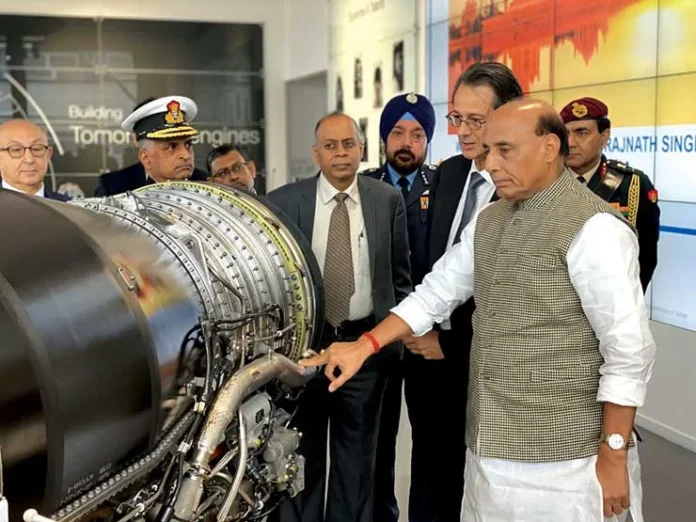As the 2022 edition of the ‘DefExpo’ gets underway in a few days, it is important to recognise the fact India’s ‘Defence and Aerospace’ sector is growing significantly, aided by the Government’s policy initiatives such as ‘Make in India’ that have created opportunities for many joint ventures with international companies. Platforms like the ‘DefExpo’ and ‘Aero India’ are providing the necessary boost and visibility to Indian manufacturing.
Recent announcements on the agreement with the Philippines to export ‘BRAHMOS’ missile is a significant achievement. Similarly, last week’s news that DRDO and SAFRAN will jointly develop the 125 KN engine for the AMCA is major news that could be transformational if the collaboration is well crafted keeping Indian interests in perspective. However, one must keep in mind that much work needs to be done beyond the optics of a defence exhibition. Translating the MoUs into real JVs is a big challenge. Unless the Indian defence industry breaks into the export market in a big way by becoming part of the global supply, the challenges to the Indian industry will continue to be significant.
Geopolitical Turmoil and the likely impact for ‘Make in India’
The current war in Ukraine and the geopolitical struggle in Europe is sure to have global repercussions and could lead to a new Cold War. This could have major implications for India’s national security and its defence industrial capabilities in the context of its large defence import-dependency. The sanctions policy of the US and the West may threaten India’s supply chain. It calls for a serious and well-measured strategic review of India’s security strategy. The policy of ‘Make in India’ needs continuous review for its effectiveness and success. With the right incentives, India can achieve one part of make in India that is manufacturing for the global market through license manufacturing with incremental value additions. However, the second and the most important part relates to technology transfers, joint research, and indigenous developments. The government must focus and stress on collaborative research and joint ventures that mandatorily have access to global supply chains.
Geopolitical storms like the current Ukraine-Russia war can have cascading effects on the rest of the world, particularly on emerging powers like India. It is all the more reason to accelerate the rapid development of Indian industrial capability, particularly in critical technology areas. With Russia being our largest source of defence equipment, sanctions like the CAATSA may begin to bite. Even joint ventures and indigenous developments may come under strain as indirect sanctions will control access to critical hardware like semiconductor chips. China’s trade and technology conflict with the US exposed its heavy dependency on the US and Western Europe for semiconductor chips and other advanced electronic components. This vulnerability led China to tweak its ‘Make in China’ policy to enhance its domestic capabilities in advanced electronic hardware to 40% by 2025. India needs to tweak its policies similarly with a clear-cut strategy. Avenues like the ‘DefExpo’ must reflect this requirement in attracting investments and joint ventures.
Importance of Aerospace and Defence

The importance of aerospace and defence technologies now transcends the military domain and is far more relevant in the civilian sector. These are critically relevant in a host of applications; navigation in space, air, land, and sea-based vehicles; communications, entertainment, remote sensing, oceanography, meteorology, construction, town planning etc. Design and development depend on a host of aerospace applications for efficient execution. Policies and strategies, therefore, will have to factor leapfrogging strategies to achieve mastery over critical technologies such as aero engines, radar systems, sensors, control systems, algorithm development, material engineering, avionics etc.
National Capabilities in the Evolving Digital World
In today’s rapidly evolving digital age, capabilities involving cyber, big data, artificial intelligence, robotics, complex algorithm developments and 5G/6G communications are already in the centre stage. India’s slow decision-making in critical technology areas has hampered its developments, application, and operationalization in critical technology areas concerning defence. The glaring example lies in the areas of NCW and Software Defined Radios. While considerable net-centric capabilities have been achieved in foundational areas like the IACCS of the IAF and the MDA of the Navy, the more critical operationalization of its airborne platforms are still languishing. Equally important, Army’s TCS and BMS have been in cold storage for long. There is an urgency to ignite rapid developments in the SDR domain to enhance the military’s netcentric capabilities. Drones and swarming have gained a boost in recent years but we must remember they are still at the development stages and the need to mature them quickly should be recognized. All of this needs a comprehensive national strategy to accelerate indigenous development in the rapidly evolving geopolitical environment.
Need for a Coherent National Aerospace Strategy
It is quite evident that major powers of the 21st century will have to be air and space powers, in short, aerospace giants. Almost all elements of aerospace technologies have dual-use characteristics. The implication is quite evident – one is that mastery over these technologies will have immense economic and military benefits to the nation. It will also accelerate the social development of the nation. The flip side is that these are hard to get technologies and will be heavily controlled through various denial regimes. India is an emerging power with a huge population and massive developmental and security needs that can translate into a huge market. Quite obviously we are large buyers of equipment and technology. We need to leverage this attractive market of ours to get access to the critical technologies.
The current unfolding geopolitical turmoil will have a major impact on technology supply chains and technology access. India will need to carefully evaluate the impact and reorient its policies with a clear focus on critical technologies as also its transformation into becoming a major player in the global arms market. The importance of developing a coherent national aerospace strategy becomes ever more urgent.
–The writer is a former Deputy Chief of Integrated Staff at IDS. He is now the President of The Peninsula Foundation at Chennai. The views expressed are personal and do not necessarily reflect the views of Raksha Anirveda
–The writer, a AVSM VM PhD (V) is a former Deputy Chief of Integrated Defence Staff for Policy, Plans, & Force Development (DCIDS – PP & FD). He is currently the President of The Peninsula Foundation, a Chennai-based public policy research think tank. The views expressed are of the writer and do not necessarily reflect the views of Raksha Anirveda














